
Pairing ideas with helianthus
6 inspirational ideas
Contents
The Helianthus or perennial sunflower is a beautiful perennial appreciated for its large golden daisy-like flowers. Similar to small sunflowers, they bloom from summer until the first frosts. Whether simple daisies or well-rounded, fully double flower heads, Helianthus has a charming, rustic, and cheerful appeal. This giant perennial can reach up to 2 metres tall and requires only sunlight and cool soil.
It is a plant that integrates well into the wilder areas of the garden, creating very bright scenes in all natural gardens! It is perfect for taking over from summer flowering.
Discover our 6 inspirations for pairing Helianthus with other equally easy-going perennials!
And, thanks to our Plantfit app, check which ones are best suited to your garden!
In a naturalistic border
With their tall and structuring stature, the great appeal of large perennial sunflowers is that they provide real structure to compositions. Their sunny flowering is essential in a natural garden, creating scenes with a wild appearance. They complement the flowering of summer-flowering perennials and autumn-flowering perennials. They should be planted in groups at the back of a wildflower bed, in a sunny location, sheltered from strong winds that could flatten the clumps. They will majestically dominate other flowers, like ‘Monarch’ or Helianthus decapetalus ‘Capenoch Star’, which form beautiful tall and bushy clumps, reaching heights of 1.50 to 1.80 m.
You might consider designing the bed around the imposing Helianthus giganteus ‘Sheila’s Sunshine’, which boasts stems reaching 2.50 m above the ground, by pairing it with other structural plants. In this case, think of Cephalaria gigantea, a giant scabious with sulphur-yellow flowers, and Eupatorium ‘Elegant Plume’, which can reach 1.80 m in height, very light with its feathery pale green foliage.
Pair the flowers of perennial sunflowers with other lush, flowering, and low-maintenance perennials in similar colours, such as the yellow ‘Chicago Sunrise’ daylilies and the ‘Bishop of York’ landscape dahlia, with bright yellow daisy-like flowers. Accompany these blooms with those of echinaceas, for example, Rudbeckia maxima, which will easily reach 1.50 m in height, and the large ‘Gruppenstolz’ daisy. Accent this natural scene with lighter-statured perennials like cosmos, which will add a sense of lightness as a counterpoint.
Complementary contrasts of yellow/blue will be achieved with the blue blooms of Perovskias, Eryngiums with their steel-blue colour, blue lupins, or Vernonia noveboracensis.
Place a few shrubs at the back of your bed that will turn purple in autumn.
For graphic appeal and lightness, add clumps of ornamental grasses with a less rigid habit than that of the sunflowers, such as Panicum or Miscanthus.

Helianthus atrorubens ‘Monarch’, cosmos, yellow daylily, Rudbeckia maxima, Eupatorium ‘Elegant Plume’, Vernonia noveboracensis, and Miscanthus ‘Graziella’
In a lush mixed border
You can take advantage of the strong presence of Helianthus to pair it with numerous perennial plants or annuals within a mixed-border in the spirit of cottage gardens.
In this type of display, the large clumps of yellow sunflowers (the ‘Soleil d’Or’ variety, for example) form tall flowering bushes until the first frosts. They are remarkable for adding a vertical and colourful note. Position them in the background and pair them with equally easy-going plants.
The vibrancy of their sunny colour and their beautiful stature are enough to infuse a cheerful and playful character into a border, as well as provide depth. They will not go unnoticed among other daisy-like flowers, annual sunflowers, a few stems of heleniums like ‘Fancy Fan’ or ‘Tijuana Brass’, Daylilies, and Echinaceas.
Complete with other summer-flowering perennials, such as Lupins, Echinops, Coreopsis, Kniphofias, and Phlox, for example. Small Bidens will help to conceal the base of their tall stems. Also consider integrating a few dahlia bulbs and late sages.
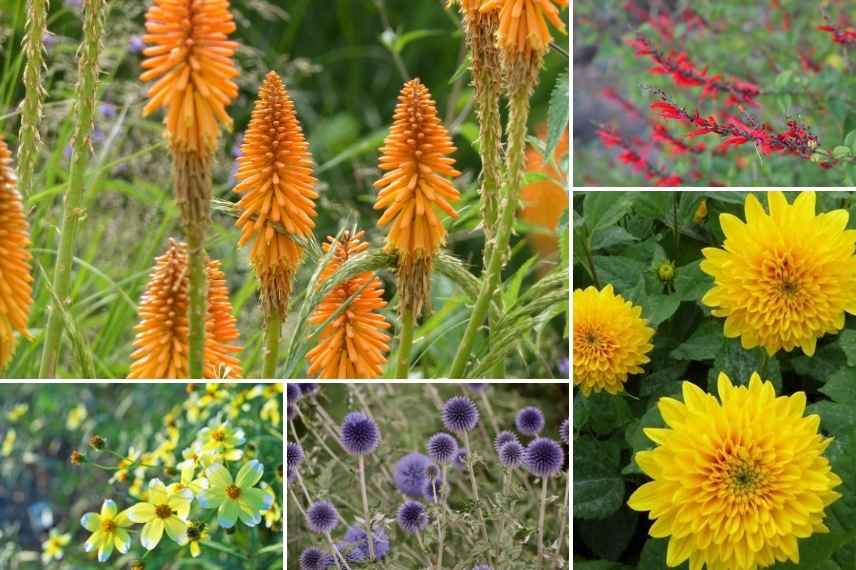
Kniphofia Fiery Fred, Salvia elegans, Bidens, Echinops, Helianthus ‘Soleil d’Or’
Discover other Helianthus
View all →Available in 1 sizes
Available in 1 sizes
Available in 1 sizes
Available in 2 sizes
Available in 2 sizes
Available in 1 sizes
Available in 1 sizes
Available in 1 sizes
Available in 1 sizes
Available in 1 sizes
In a meadow garden
Helianthus blooms all summer, from June to early autumn, in naturalistic borders, cottage gardens, and contemporary meadow gardens! To flower a sunny naturalistic meadow with minimal effort, mix hardy and very robust perennials that grow on their own. Choose plants with a rustic appearance to accompany the Helianthus microcephalus or the ‘Lemon Queen’ variety with its abundant lemon-yellow flowers. Tall asters, Aster novi-belgii and Aster novae-angliae easily integrate into this type of display alongside, for example, yarrow and grasses.
Also consider other “wildflowers”; Leucanthemums, Eryngiums, large-flowered Fleabanes, Buenos Aires Verbenas, Eupatorium, Echinacea paradoxa, with its long and abundant golden-yellow summer flowering, and Coreopsis grandiflora ‘Sonnenkind‘, with its large bright yellow daisies.
Grasses, such as Miscanthus, Calamagrostis brachytricha, a lovely grass, or tufted canes will add lightness and volume to the overall composition. Also discover the Andropogon gerardii ‘Prairie Sommer’, a large and very hardy grass.

Helianthus Lemon Queen in the bottom left accompanied by Asters novi-belgii, Leucanthemums, Echinacea paradoxa, Yarrow, and Andropogon gerardii ‘Prairie Sommer’
Graphic with grasses
The sturdy, proudly upright stems of the Helianthus or perennial sunflower introduce vigorous accents to a flowerbed. Its colourful and opulent flowering pairs well with the more airy, graphic nature of grasses. They allow for the creation of a scene that is both contemporary and wild.
For example, choose Panicum virgatum ‘Cloud Nine’, with its golden-yellow spikelets, a Calamagrostis ‘Karl Foerster’, miscanthus, and stipas. They are the ideal companions to counterbalance the somewhat stiff habit of the helianthus, bringing softness and a lovely lightness to a naturalistic scene. On this foundation, which forms the structure of the flowerbed, you can, for instance, combine the yellow and double flowering of Helianthus decapetalus ‘Plenus’ with Stipa gigantea, or giant stipa, reaching heights of 1.8 to 2m, whose gracefully arching panicles in silvery-purple, then golden, will lighten the somewhat heavy flowering of this variety of perennial sunflower.
The Molinia caerulea ssp arundinacea ‘Transparent’, a tall ornamental grass nearly 2 metres high with spikelets so delicate they appear transparent, will also look stunning alongside it.
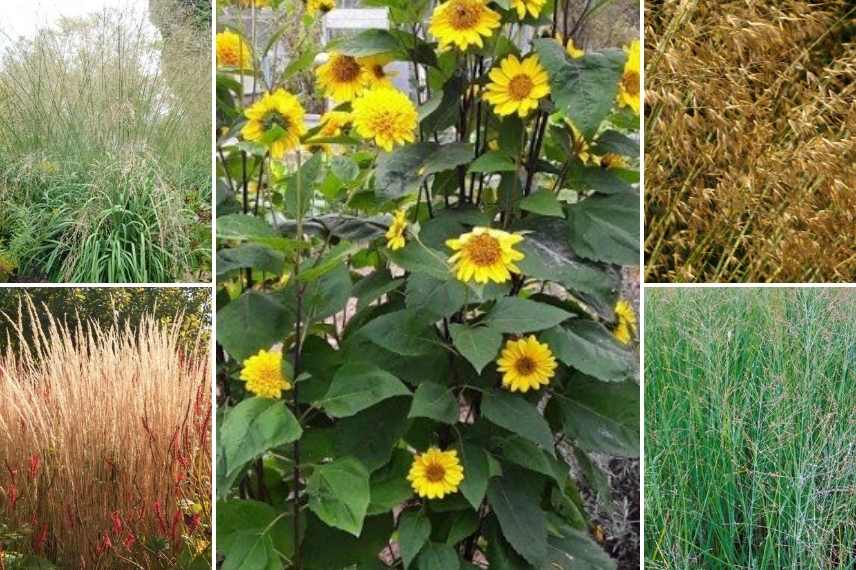
Helianthus decapetalus ‘Plenus’, Molinia caerulea ssp arundinacea ‘Transparent’, Calamagrostis ‘Karl Foerster’, Stipa gigantea, and Panicum virgatum ‘Cloud Nine’
With roses
The large perennial sunflowers are also excellent companions for late-flowering roses. These robust perennials will benefit from being accompanied by a bed of groundcover roses that will dress the base of their stems and accompany their flowering until the first fires of autumn. For example, you might choose the rose ‘Golden Border’, a variety of clustered-flower rose, small and compact (averaging 60 cm in height with a spread of 50 cm), which bears beautiful bright yellow roses from June to November. It will form a superb carpet at its base, bringing a lot of cheer in late summer. Plant it in masses or alongside other groundcover roses blooming in the same colours, such as the Decorosier ® Celina ® rose which bears semi-double flowers of a soft yellow, or the rose ‘Lemon Fizz’, another sunny rose.
These floriferous and low-maintenance roses will be perfect in a natural garden to create a dynamically bright late-season display. Add contrast by punctuating the whole with the lavender-blue flowering of the Aster cordifolius ‘Blue Heaven’.
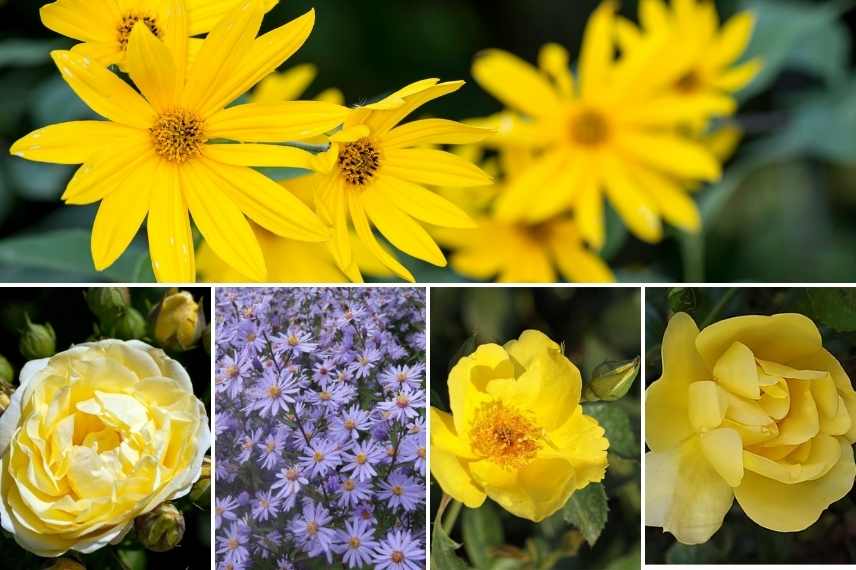
Helianthus tuberosus, rose ‘Golden Border’, Asters cordifolius ‘Blue Heaven’, dwarf rose ‘Lemon Fizz’ and Decorosier ‘Célina’ rose
In a beautiful autumn scene
The great appeal of the Perennial Sunflower lies in its late flowering, which bridges the gap between summer and autumn perennials that are just beginning to bloom. It naturally finds its place in an autumn border with unparalleled brightness. Autumn asters, Japanese Anemones, the late yellow flowers of Solidago, and large coreopsis such as ‘Louis d’Or’ will accompany its flowering right up to the gates of autumn, as will the delicate Buenos Aires verbena (Verbena bonariensis) and Perovskia atriplicifolia.
In an open and sunny garden, Silphium perfoliatum is another very tall perennial with yellow daisy-like flowers, perfect for accompanying it as well.
When planted in masses in front of shrub borders, its sunny flowering will stand out beautifully against the foliage of autumn-coloured shrubs such as deciduous euonymus, Cotinus, and Parrotia persica…

Helianthus microcephalus, Cotinus coggygria, Solidago, Japanese Anemone, Silphium perfoliatum, Verbena bonariensis, and Coreopsis Louis d’Or’
- Subscribe!
- Contents

































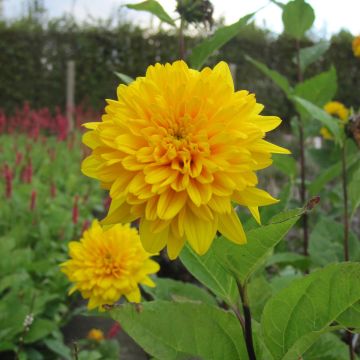
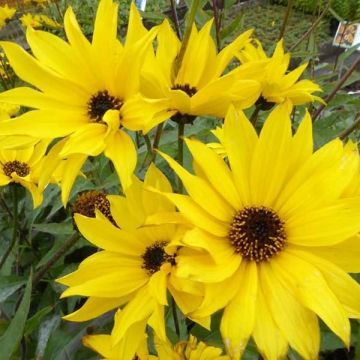
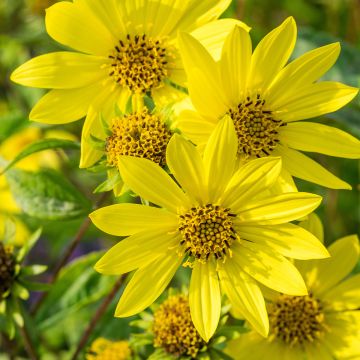
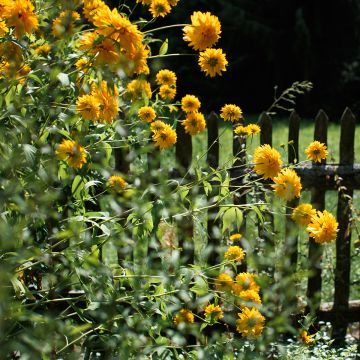
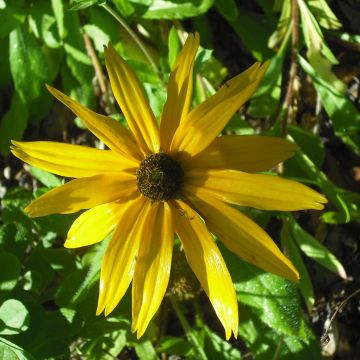
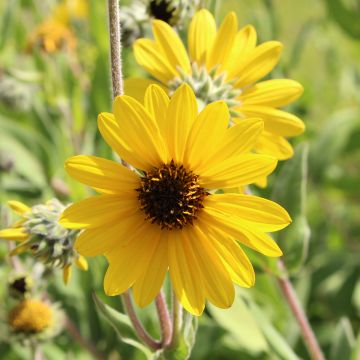

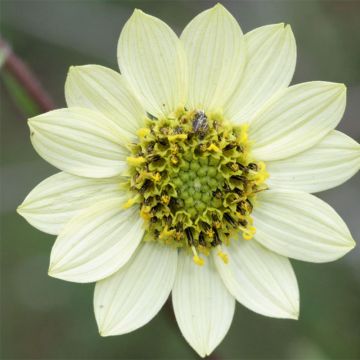
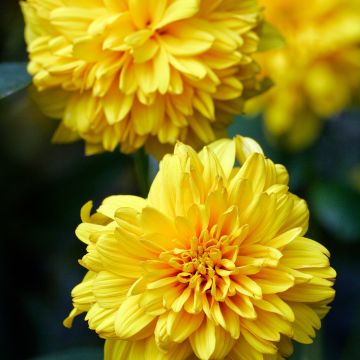
Comments